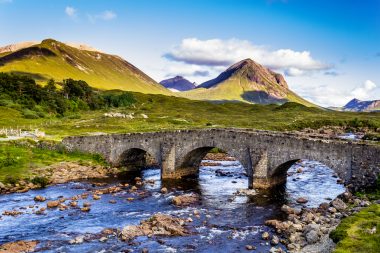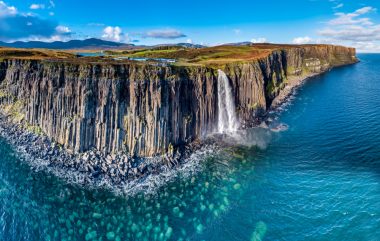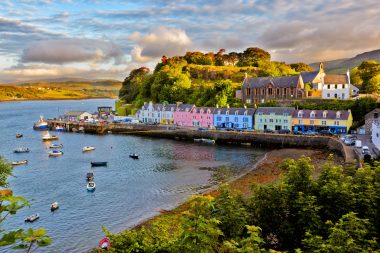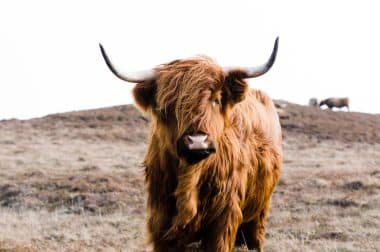The Isle of Skye is the largest and most famous island in the Inner Hebrides. It is located on the west side of Scotland and has been accessible via the Skye Bridge since 1995. Skye measures a maximum of 40 kilometres in width and is around 80 kilometres long.
On Skye, light and landscape merge into an unforgettable atmosphere. Breathtaking Highland panoramas, castles, whisky distilleries and picturesque harbour towns take visitors into their very own island world.
In the small main town of Portree, the colourful houses at the harbour are particularly eye-catching. Many of the island’s place signs are written in English and Gaelic.
Water again and again

The inlets that reach far into the interior of the island divide Skye into many peninsulas. The largest are Duirinish, Waternish and Trotternish in the north and Minginish and Sleat in the southern half.
In general, water plays a central role in the landscape of Skye. Numerous lochs – as lakes, bays or fjords in Scotland are called – run through the island. Depending on the weather, cloud formation, incidence of light and time of day, they provide impressive postcard motifs. It is worth having good photo equipment with you when travelling on Skye.
Eventful history and historic buildings

The island has been inhabited since the Mesolithic Age. The brochs, round towers from the Iron Age, as well as stone circles and other witnesses of the past are impressive reminders of the former island life.
Skye looks back on a turbulent history. Again and again there were battles, looting and devastation. From the 8th century onwards, the Vikings ruled Skye. The Clan MacLeod had power from the year 1090. Around 1156, the rule of the MacDonald clan began.
Dunvegan Castle is the ancestral seat of the MacLeod clan. Both the gardens and the interior of the castle are worth a visit.
Armadale Castle in the south of the island is the former manor house of the Clan MacDonald. The castle is partly dilapidated. The gardens with their exotic plants and the Museum of the Isles on the castle grounds are worth seeing.
The Sligachan Bridge is one of the most famous bridges in the Highlands. It dates from around 1820 and is located between Portree and Broadford on the A87. With three arches, the old stone bridge spans the Sligachan River. The Black Cuillins behind it form a mysterious mountain backdrop.
Skye – Dramatic Natural Landscapes

In the south of the island, the mighty Cuillins impress with their red and sharp-edged black mountain formations. Many peaks are almost 1000 meters high.
On the peninsulas in the north, the mountains have softer and often bizarre shapes. Examples include the flattened peaks of MacLeod’s Tables and The Needle and The Table rocks in the Quiraing.
Only about 10 kilometres from Portree is the Old Man of Storr – a striking, almost 50-metre-high basalt column in the shape of a menhir. The approximately 45-minute ascent from the car park is rewarded with a fantastic view over the water and island world.
The Fairy Glen valley near Uig must have been designed by fairies – at least that’s what the islanders thought. The bizarre rocks and hills, pools and waterfalls create a magical atmosphere.
Against the backdrop of the Black Cuillins, crystal-clear water flows over cascades into greenish shimmering rock pools near Loch Brittle. Is this the bathing place of fairies? In any case, the Fairy Pools are a popular destination for hikers.
Talisker Bay, with its two-tone sandy beach, cliffs and waterfall, and the cliffs of Neist Point in the west of the island also offer an abundance of scenic charms.
Enjoyment in Scottish
Whisky is just as much a part of Scotland as the Highlands, bagpipes and kilt – the wool wrap skirt that men wear in Scotland. Two distilleries distill their whisky on Skye. Both Talisker Distillery and Torabhaig Distillery offer guided tours and tastings.
The ales of the Isle of Skye Brewing Company, gin of the Isle of Skye Distillers and sea salt of the Isle of Skye Sea Salt Company are other typical island products.
In the field of gastronomy, Skye has developed enormously in recent years. Good restaurants are not only in Portree.
Skye – Rich Wildlife

Skye is home to many wild animals. These include sea eagles, dolphins, whales and red deer. Boat trips, guided exploration tours and hikes are the best way to discover the impressive fauna of the Isle of Skye.
- Red Deer: These majestic animals are quite common on the Isle of Skye and can be spotted in the mountains and hills of the island.
- Sea Eagles: The Isle of Skye is known for its population of white-tailed eagles, one of the largest species of birds of prey in the world. They can often fly along the coastline or over the mountains.
- Scottish Highland Cattle: These hardy and hairy cattle are a symbol of the Scottish countryside and are also bred on the Isle of Skye. They are known for their impressive horns and thick fur that protects them from the harsh weather conditions.
- Birds of Prey: As well as white-tailed eagles, the Isle of Skye is also home to other birds of prey such as peregrine falcons, buzzards and owls that live in the island’s rocks and forests.
- Seals (Seals): Colonies of seals can often be spotted on the coastlines of Skye, sunbathing on the rocks or swimming in the sea.
- Scottish Wildcat: Although rare, there are still some populations of the Scottish wildcat, an endangered subspecies of the European wildcat, on the Isle of Skye.
- Seabirds: Various species of seabirds can be spotted along the island’s coastlines, such as razorbills, gannets and guillemots, which often breed on the cliffs.
Travel tips on Skye
- Sheep are the true masters of Skye. They determine the speed of all road users when the herds stroll leisurely across the road. Then only patience helps.
- Skye is a paradise for walking and climbing. Rugged rocks, gentle fairy landscapes, waterfalls and ancient places of worship make for unforgettable experiences. However, weatherproof clothing and a good sense of direction are necessary to enjoy the hiking tours.
- Whether dinosaur tracks, basalt columns or impressive starry skies – there is endless to discover on Skye.
The climate on the Isle of Skye
| Month | Average maximum temperature (°C) | Average low temperature (°C) | Average rainfall (mm) |
|---|---|---|---|
| January | 6 | 2 | 170 |
| February | 6 | 2 | 140 |
| March | 8 | 3 | 140 |
| April | 10 | 4 | 100 |
| May | 13 | 6 | 90 |
| June | 15 | 9 | 80 |
| July | 17 | 11 | 90 |
| August | 17 | 11 | 100 |
| September | 15 | 9 | 110 |
| October | 12 | 6 | 140 |
| November | 9 | 4 | 160 |
| December | 7 | 3 | 170 |


